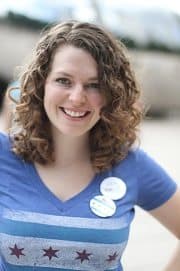Welcome to Chicago! It is a great city to explore. Here is a self-guided tour of the downtown area. This is a mere sampling of some of the hidden and not-so-hidden gems in the downtown area of Chicago.
The Quincy Train Station (Intersection of Quincy and Wells- off of the Brown/Pink/Orange/Green Line)
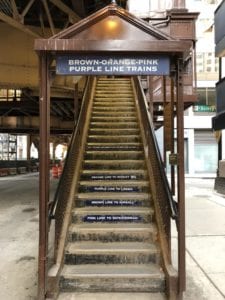
The Loop is quite literally the section of the city within the circle or loop that the L makes. Riding public transportation is a big part of living in Chicago. If you want to travel and live like a local - ride the L! Many of the stations even have art installations (http://www.transitchicago.com/art/) which makes them a neat destination! This includes Western Brown station which holds a part of the Berlin Wall given to the Chicago by the City of Berlin.
The Quincy Station, designed by Alfred M. Hedley, was built in 1897 and is the oldest remaining ‘L’ station in Chicago. The station has been historically renovated to its original appearance. Make sure as you walk to next stop to turn around and have a look at the station between the buildings.
Head West on Quincy Street, it's really the only direction you can go as the other direction is closed to pedestrians.

This iconic black building towering above you is Chicago’s famous Willis (Sears) Tower! It is 110 stories and was the tallest building in the world from 1973 to 1998. Today, it is 2nd tallest in the US (after the World Trade Center) and 16th in the world.
It was built by Sears, Roebuck & Co, at the time the largest retailer in the world. In 2003 when the naming rights expired, a London based insurance broker, Willis Group Holdings, acquired the rights - though many people still call it Sears Tower.
To see a spectacular view, head to the 103rd floor Skydeck on The Ledge, a glass balcony that extends from the building. This building is the first stop on our guided Birth of the Skyscraper: Architecture Tour!
Take a right on Franklin and then left at Adams to do a half circle around the Willis Tower. You will then take a right onto Wacker. Walk along Wacker until you pass Madison. You'll see our next stop at 20 N. Wacker Street on your left.
The Civic Opera Building (20 N. Wacker)
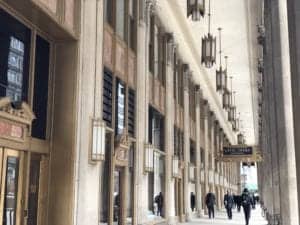
If you look at the building from the river view, you will see that it is shaped like a large throne. If you've seen Orson Welles' film Citizen Kane, this may look familiar. It was the inspiration for the opera house featured in the movie.
The Lyric Opera of Chicago made this building its permanent home in the 90’s.
This building is also talked about on our West Loop: The Gateway Tour.
Head back to Madison and turn left away from the river. You'll be on Madison for a few blocks and then pop into 200 W. Madison on the left side of the street.
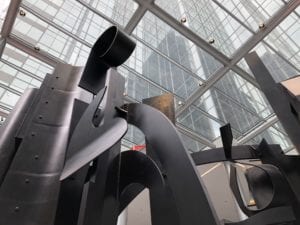
If you need a moment to warm up- head into 200 W. Madison. This is an office building with some really incredible lobby art.
On the north wall, there is a piece entitled ‘Spring’ which is made of live plants. This piece is part of 2016 renovations by artists Dan Cheetham & Michelle Tarsney. There are four pieces to represent earth, wind and water. The wood sculpture, Hypnotic Field, corresponded to earth, the hanging sculpture, Soar, was inspired by wind, and the living wall, Spring, references water.
Representing fire is a large black sculpture is entitled Dawn Shadows. It was inspired by the elevated train systems on Chicago. In fact, the best view of the piece is the elevated train platform just above 200 West Madison’s Lobby. It was commissioned from artist, Louise Nevelson, in 1982.
There is a Starbucks in the lobby and comfortable chairs if you want to sit and appreciate the art.
Exit the building and across the street you'll see Walgreens on the corner.
Walgreens (Intersection of Wells and Madison)
You will pass a Walgreens Drugstore on the right. This 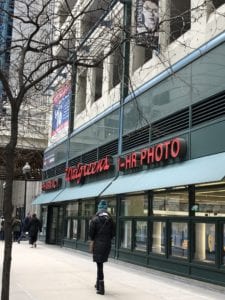
The story goes that Charles had an accident working at a shoe factory that resulted in his middle finger being cut off at the joint. This injury meant he couldn’t play sports and instead changed his interests to become a pharmacist.
Continue heading down Madison (you're going East, against the flow of traffic). Enjoy the view of the tall office buildings. Once you cross LaSalle Street, look for the church on your left.

St. Peter’s Church (110 West Madison)
St. Peter’s Catholic Church was founded in 1846 but didn’t move into this structure until the 1950s. When it moved into this Art Deco building it wasn't a traditional neighborhood parish as there wasn't a traditional neighborhood - instead it was dedicated to serving the thousands of Loop workers.
The façade is a large crucifix designed by Arvid Strauss entitled “Christ of the Loop” and is quite a site to see! If you go inside you'll see more statues in place of the usual stained glass - and that's because there are buildings on either side and no place for windows!
Continue down Madison and take a left onto Clark Street

This synagogue was built in 1957 by architects Loebl, Schlossman, & Bennett. It is the home of an Orthodox Jewish congregation. Similar to St. Peter's it was originally dedicated to serving Loop workers but now a residential community has developed in the Loop.
The exterior has an incredible bronze sculpture by Henri Azaz. It is made up of scriptural words of blessing in Hebrew and English as well as two hands.
The words are in English and Hebrew,
from the prayer from the Book of Numbers..
The Lord bless thee and keep thee;
the Lord make His face to shine upon thee and to give three peace..
Turn around to see the curved Chase building at Clark and Madison and then head back to Madison to walk east.

The Chase building is 60 stories with a distinct curved shape. It was built in 1969 by a Japanese architect with Perkins and Will.
It is a great example of a lovely modern structure within the Loop and it is the tallest building in the actual L-defined Loop area. This building is also on our Loop & Millennium Park Tour.
Be sure to check out the Marc Chagall mural, Four Seasons, in the sunken plaza nearby. The mosaic wraps around a large rectangular box and is now protected by a glass canopy. This gift was dedicated in 1974.
Continue east on Madison until you arrive at the intersection of State and Madison
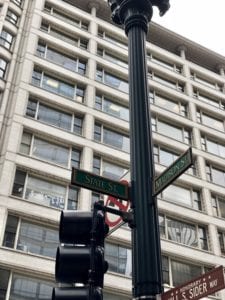
This intersection represents the beginning of the numbering system for the streets in Chicago. Madison is the North-South dividing line whereas State is the East-West dividing line.
Cross the street to get an up-close view of the old Louis Sullivan Carson Prairie Scott Building on the Southeast corn of State and Madison.
Old Carson Prairie Scott & Co. Building (Target) (1 S. State St.)
This building is a great example of American architecture in the late 1800’s. This building has been a retail location since 1899 from the Schlesinger & Mayer dry goods store to Target today.
The architect is famed Louis Sullivan who was known for pushing architectural boundaries and drawing inspiration from nature. The cast iron decoration on the front of the building is especially striking.
When Target bought this building in 2011, locals were concerned about its future. Target embraced the beauty of the building and even found ways to complement it. The Target logos displayed in the windows have a unique design that is meant to emulate the cast iron decoration on the building.
Look or walk across the street from Target on the north side of Madison.
Garrett’s Popcorn (4 E. Madison)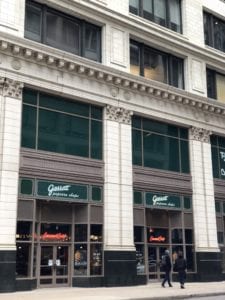
Popcorn is Chicago’s official snack food! One of the most popular popcorn shops is Garrett’s which was established in 1949. Originally, Garrett’s had caramel, cheese, and plain popcorn. The story goes that patrons in the seventies would always order caramel and cheese but then they would just mix it together. This was the birth of the Chicago Mix!
In the 90’s a candy company in Minnesota actually trademarked the name “Chicago Mix” and recently sued Garrett’s for using the name. Of course, this won’t stop the locals from using the real name while ordering their popcorn.
Continue East on Madison under the L tracks and then take a right onto Michigan Ave.
Chicago Athletic Association (12 S. Michigan Ave.)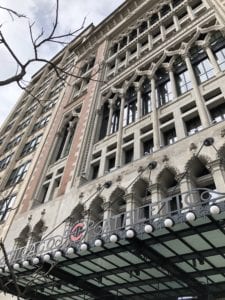
Originally this 1893 building was a private health club and now it is a boutique hotel! The current owners have really shined this gem and made it a lovely building to appreciate from the outside and to explore the inside. Walk into the building and head to the grand staircase behind the security desk. When you look down, you will see the old swimming pool tiled floor. The second floor lobby is filled with little Easter eggs to discover. For example, take a good look at all of the trophies displayed! This hotel has some great places to eat as well. The rooftop bar is amazing!
Cross Michigan Ave. and take a right along the side walk. You will see two large boxes on your left. Take the path and stairs to stand near these two boxes.
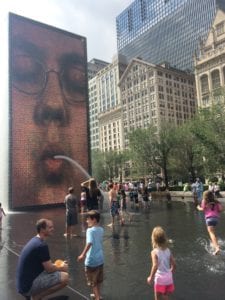
You are looking at Catalan artist, Jaume Plensa’s Crown Fountain. It is a black granite reflecting pool between dual 50 feet glass brick sculptures with LED screens that feature over 1000 different Chicagoans! The faces are all representational of the diverse citizenship of Chicago, and water spouts from their mouths in the style of Gothic Gargoyle fountains. Plensa, born in 1955, aims to reach his audience on an intuitive level, often dealing in dualities with his world renowned pieces.
This sculpture is a Chicago favorite. The water operates from May to October. You will notice that every seven minutes or so the faces will pucker their lips and water will come streaming out! This is a favorite for families with young kiddos during the warm months to play in the reflecting pool.
Stay in the park area and mosey north past Crown Fountain. Take the stairs or ramp on your right side. You will enter the next park section on the left.
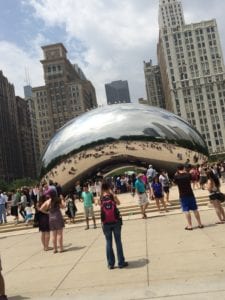
We conclude our self-guided tour walking around Cloud Gate- a giant stainless steel sculpture designed by Anish Kapoor. It has become an icon in the Windy City despite being relatively new in our older city as it was unveiled in May of 2006. It has 168 stainless steel plates that have been welded together seamlessly and weighs 110 short tons. Cloud Gate is featured in movies like The Break Up, Source Code, and The Vow.
This internationally recognized contemporary sculpture by Anish Kapoor might look like it’s loving nickname, “The Bean”, but completing Cloud Gate was no small task! Assembled with nearly 200 stainless steel plates, Kapoor’s sculpture cost $26 million dollars to complete. But, as it now serves as perhaps the most visited attraction for travelers and tourists of Chicago, we’d say it was well worth the effort!
Anish Kapoor is an English sculptor, having studied at Hornsey College of Art and Chelsea School of Art Design. Cloud Gate was his first United States installment, weighing in at 100 tons.
This is an excellent place to take selfies. Cloud Gate is also a favorite spot for pictures of the Chicago Skyline. Pittsfield, Leo Burnett, The Heritage, Smurfit-Stone, and One Prudential Plaza buildings are just a few pictured below.
This is also the ending location of the guided Loop & Millennium Park Tour.
After you complete this self-guided tour- you may be interested in strolling through Millennium Park with our self-guided tour of the park!
https://freetoursbyfoot.com/millennium-park-chicago-map-and-tour/






